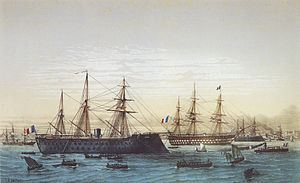Name Magenta Laid down 22 June 1859 Displacement 7,129 tonnes Launched 22 June 1861 Weight 7,129 tons | Construction started 22 June 1859 Length 92 m Beam 17 m | |
 | ||
Fate Exploded and sank 31 October 1875 | ||
Magenta was a broadside ironclad of the French Navy, lead ship of her class. She served as flagship of the Mediterranean Squadron.
On 21 July 1875, Magenta was serving as flagship in a naval exercise involving six ironclads – Magenta and five Alma-class central battery ironclads – and a number of smaller ships in the Tyrrhenian Sea off the east coast of Corsica . The ironclads were steaming in beautiful weather at 8 knots in two parallel columns, with Magenta leading one column, followed by Jeanne d′Arc and Reine Blanche, and Armide leading the other, followed by Thétis and Alma. At 12:00 noon the admiral commanding the squadron ordered the screw corvette Forfait, operating as a dispatch vessel, to pass astern of Magenta to receive orders. Attempting to place his ship in the column between Magenta and Jeanne d′Arc, the commanding officer of Forfait misjudged his turn, and Jeanne d′Arc collided with Forfait, her ram bow tearing into Forfait′s side. Forfait sank 14 minutes later, her crew of 160 taking safely to her boats; her commanding officer floated free from the bridge as Forfait sank beneath him, but also was rescued.
On 31 October 1875, an accidental nighttime galley fire started aboard Magenta while she was in port at the naval base at Toulon, France, and spread out of control. Her crew was able to flood her forward gunpowder magazine but could not reach her after magazine. When it became clear that the ship could not be saved, her crew abandoned ship, and Magenta′s after magazine exploded shortly afterward, 2 hours 55 minutes after the fire broke out. She sank in 15 meters (49 feet) of water. At the time of the accident, Magenta had a cargo of Carthaginian antiques, notably 2080 Punic stelae (Tophet, 2nd century BC) and a marble statue of Vibia Sabina (Thasos, c. 127-128 AD), found in 1874 by the Pricot de Sainte-Marie mission.
The wreck was located in April 1994. Fragments of stelae have since been recovered. The statue has been partially recovered, though the head was too damaged to be rejoined to the rest of the statue. The fragments are on display at the Louvre in Paris.
